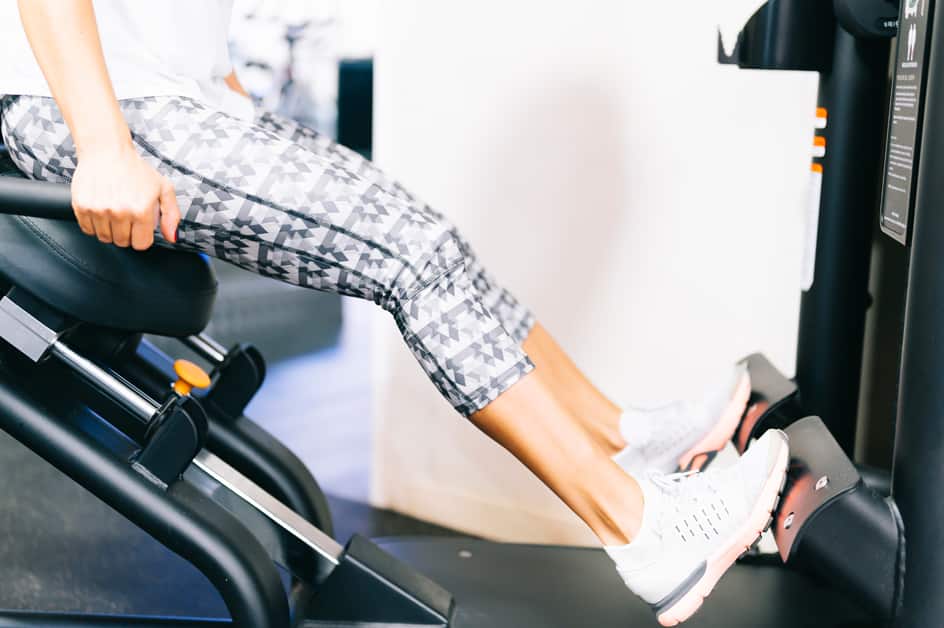Introduction
Knee pain is a common problem among adults. Weak leg muscles, due to age, are often the cause. However, there are exercises that can help improve strength and reduce pain. These target both the quadriceps and hamstrings.
Doing these regularly can improve range of motion and reduce inflammation and soreness from arthritis or general wear & tear. In addition, balance and agility will improve. Here are five effective exercises to strengthen the leg muscles and provide better support for the knees:
Exercise 1: Step-Ups
Step-ups are a great way to increase leg strength and ease knee discomfort. Stand upright in front of a step or bench. Put your right foot on the step or bench. Follow with your left foot. Push up with your right leg and bring your left foot down. Do this on both sides.
Step-ups will help to strengthen your leg muscles as well as improve balance and stability.
Benefits
Step-ups are a great leg exercise. They don’t need much equipment and can be done anywhere. Benefits include:
- More leg strength and power. Step-ups use the major muscles in the legs, like the quadriceps, hamstrings, calves, and glutes. Doing this exercise often can increase core strength and balance. It can also reduce knee pain.
- Better flexibility. Step-ups stretch the calf muscles and hip flexors. This helps with range of motion and movement quality.
- Less strain on the joints. Step-ups are a weight-bearing activity. This helps spread the load from activities like running to other muscles in the legs.
- Enhanced athletic performance. Doing step-ups regularly boosts power when sprinting. It also helps with efficient running mechanics.
Step-by-Step Instructions
Step-ups are great for strength-training. They work your hips, glutes, thighs and calves. Doing this exercise can help reduce pain and symptoms of knee joint conditions like arthritis, patellofemoral syndrome, tendinitis and other knee injuries. Regularly performing step-ups can reduce your pain levels over time, and improve your mobility.
Here’s how to do it:
- Stand with your feet shoulder-width apart, evenly distributing your weight between both legs. You can start with one leg, without supporting your bodyweight on the other side, for better balance and form.
- Step firmly onto one foot and raise your torso to the bench level or platform. Avoid pushing off with your back foot. Use only the muscles in the leading leg.
- Lower yourself down into an extended standing position. Engage your core muscles to provide stability throughout each movement. Keep both feet firmly on the ground during the entire movement. Try to slow down as much as possible while completing the exercise.
- Do ten repetitions on each leg before changing sides (if using single leg). Perform three sets of 10 repetitions per day. This will give you optimal results. Do this after warming up or cooling down from other workouts that include legs.
Exercise 2: Lunges
Lunges are great leg-strengthening workouts. They can help reduce knee pain. Move one leg forward and the other back with a deep bend in the knee for each rep. Be careful to do them correctly for safety and to get maximum results.
Here’s more info on how to lunge properly and the many benefits it provides:
Benefits
Lunges are an awesome way to build the strength of your legs and lessen knee pain. Plus, there are a few other benefits of doing lunges:
- Increased leg strength and stability. Lunges work out the whole leg, particularly the quads and glutes. Also, key stabilizing muscles at the knee joint get stronger. A study on recreational soccer players showed that adding lunges to their program improved lower body strength, balance, and agility.
- Improved posture. Lunges work several different core and leg muscles, like the hamstrings, glutes, quads, lower back muscles, and hip flexors. And, these are important muscles for good standing or sitting posture.
- Improved coordination. Doing lunges can help your body transfer force between its parts. This is helpful in sports where power needs to be shifted quickly.
- Injury prevention. Adding lunges to your routine can help reduce knee pain, as well as provide extra support to vulnerable joints due to injury. It is also a great way to strengthen muscles around weak joints.
Step-by-Step Instructions
Instructions for Lunges:
- Stand, feet hip-width apart. Arms bent at the elbows.
- Take a long step forward with one foot. Bend both legs to 90 degrees. Back and torso straight.
- Ensure front knee is over ankle. Not beyond toes.
- Back leg hovers off ground. Never touching it.
- Slowly lower into stretch. Feel it in thigh and hip flexors. Hold two/three seconds. Push back up.
- Do 3 sets. 8 reps on each side. Rest 1 minute between sets.
Exercise 3: Squats
Squats are great for strengthening legs and core muscles. Plus, they can ease knee pain. Squats build muscles around the knee joint and boost stability and flexibility. Plus, they improve range of motion.
Want to know more? Read on for squatting benefits and tips to get the best results!
Benefits
Squats were initially done to help build strength in the lower body. They remain a key part of many strength training plans for runners and athletes. Squats are also useful for those with mild to moderate knee pain. This is because they help boost leg strength and flexibility, reducing strain on the knees during other exercises.
The benefits of squats depend on your fitness level. Begin slowly with 10 repetitions at a low weight until your muscles are stronger. This is essential to prevent injuries and maximize loading for muscle growth.
Doing squats adds muscle activation throughout the leg, such as calves, hamstrings, glutes, quads and hip adductors. This helps improve knee stability and reduces knee pain, even when doing high-impact exercises. Also, squats can reduce physical deformations caused by arthritis in the knees. Finally, squats help reduce friction between knee joints and cartilage, reducing inflammation for those living with chronic knee conditions such as arthritis or tendinitis.
Step-by-Step Instructions
Squats are great for strengthening the muscles around your knees and providing relief from pain. Here’s a guide:
- Stand with feet hip-width apart and toes slightly pointed out.
- Chest forward, core engaged, weight on heels.
- Bend your knees, making sure they don’t go past your toes.
- Lower yourself till you form a 90 degree angle with your legs.
- Push against the floor, use your legs to stand back up and squeeze your glutes.
- Do 10 to 15 reps for 2 to 3 sets, as desired.
Exercise 4: Leg Raises
Leg raises are a great way to work out your leg muscles without too much strain on joints. They can help build muscle, improve coordination, and relieve knee pain. Additionally, leg raises can help with posture and core stability.
Let’s look at how to do them properly and what benefits there are:
Benefits
Leg raises are an awesome workout! They can help build glute muscles, quads, and hamstrings. This makes your knees more stable and lessens knee pain. It also gives you better control when you move, so you don’t get hurt.
Stronger muscles around your knees protect and support your ligaments when you do everyday activities. You can also add hip flexor stretches and wall squats to enhance your knee stability.
Doing leg raises on the reg can help reduce knee pain caused by weak muscles or a wobbly joint.
Step-by-Step Instructions
Leg raises can strengthen both quads and hamstrings, giving knee stability and protection. Do leg raises for knee pain relief this way:
- Lie flat on the ground, arms at sides.
- Use abs to lift one leg up to the ceiling, keeping it extended and straight.
- Lower it till it’s an inch from the ground.
- Repeat 8-12 times, then switch legs. Do two sets at the same reps per leg.
- To modify, put a rolled-up towel or foam roller under your lower back if you feel pain in your lumbar spine or hips.
Focus on slow, controlled movement in each rep to build strength without risking injury to already painful knees. This helps recovery progress and prevents bigger problems in the future.
Exercise 5: Calf Raises
Calf raises are fab! They help strengthen the lower legs, reduce knee pain and increase muscle flexibility and balance. To do it, keep both legs straight and do reps together. You can also do one-leg calf raises if you want to target a certain spot.
Read on to find out more about the benefits of this exercise and how to do it right:
Benefits
Calf raises, or toe raises, are fantastic for strengthening calf muscles! Not only do they make your legs look great and tone up muscles, but also offer health perks. Improved calf strength can reduce the chance of injury from falls. They also protect the knee joint by stabilizing your body while running or doing physical activities.
Additionally, calf raises can ease pressure in the Achilles tendon. This may help with chronic pain after exercising. Athletes use this exercise to prevent injuries and rehab existing leg injuries. Lastly, it increases flexibility in the ankles. This can stop stiffness that can cause pain when walking or running long distances.
Step-by-Step Instructions
Calf Raises are a great way to build up the muscles around your knees and reduce knee osteoarthritis pain. When done properly, this exercise can help with joint mobility, balance and gait stability.
Here are the steps:
- Stand close to a wall or stable object for support. Put your feet hip-width apart.
- Slowly rise up onto the balls of your feet and lift your heels as high as you can.
- Come back down to the starting position in a slow and controlled way.
- Do 8-12 reps and 2-3 sets daily, depending on your comfort, preferences and rehab program needs.
- If you’re feeling good with this exercise, add weight (dumbbells) for extra resistance and more muscle strength in the calf muscles.
Conclusion
Do you suffer from chronic knee pain? Or just want to keep your joints healthy? Try these five effective leg strengthening exercises! Start slow and gradually increase your repetitions. Listen to your body, but stick with the routine for the best results. Strengthening your legs and improving knee stability can help reduce knee pain and avoid injury.
If you experience pain or joint discomfort lasting more than a day, stop the exercises and consult a physical therapist or medical professional. They can create an effective treatment plan tailored to your needs.
Frequently Asked Questions
Q: What are the most effective leg strengthening exercises for knee pain relief?
A: Squats, wall sits, mini-squats, step-ups, and calf raises are all effective leg strengthening exercises that can help with knee pain relief.
Q: How often should I perform the exercises?
A: You should aim to perform these exercises at least three times a week to get the best results. Make sure to give your muscles a break in between sets.
Q: How can I make sure I’m doing the exercises correctly?
A: It’s important to make sure you’re performing the exercises correctly to avoid any further injury. Be sure to consult a doctor or physical therapist first, and have them guide you through the exercises to make sure you’re using the proper form.





